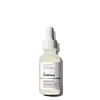What's inside
What's inside
 Key Ingredients
Key Ingredients

 Benefits
Benefits

 Concerns
Concerns

No concerns
 Ingredients Side-by-side
Ingredients Side-by-side

Water
Skin ConditioningAlcohol
AntimicrobialDipropylene Glycol
HumectantButylene Glycol
HumectantGlycerin
HumectantDiglycerin
HumectantPEG/PPG-14/7 Dimethyl Ether
Skin ConditioningPotassium Methoxysalicylate
BleachingLactobacillus/Rice Ferment
Skin ConditioningPEG-60 Hydrogenated Castor Oil
EmulsifyingDiphenylsiloxy Phenyl Trimethicone
Skin ConditioningErythritol
HumectantDipotassium Glycyrrhizate
HumectantXanthan Gum
EmulsifyingSodium Polyacrylate
AbsorbentCitrus Junos Fruit Extract
Skin ConditioningSodium Acetylated Hyaluronate
HumectantSodium Hyaluronate
HumectantHamamelis Virginiana Leaf Extract
Skin ConditioningCarbomer
Emulsion StabilisingPolyglyceryl-2 Diisostearate
EmulsifyingPotassium Hydroxide
BufferingDisodium EDTA
Isostearyl Alcohol
EmollientIsostearic Acid
CleansingSodium Citrate
BufferingCitric Acid
BufferingLinalool
PerfumingGeraniol
PerfumingHexyl Cinnamal
PerfumingCitronellol
PerfumingSodium Metabisulfite
AntioxidantAlpha-Isomethyl Ionone
PerfumingLimonene
PerfumingPhenoxyethanol
PreservativeParfum
MaskingCI 17200
Cosmetic ColorantCI 19140
Cosmetic ColorantWater, Alcohol, Dipropylene Glycol, Butylene Glycol, Glycerin, Diglycerin, PEG/PPG-14/7 Dimethyl Ether, Potassium Methoxysalicylate, Lactobacillus/Rice Ferment, PEG-60 Hydrogenated Castor Oil, Diphenylsiloxy Phenyl Trimethicone, Erythritol, Dipotassium Glycyrrhizate, Xanthan Gum, Sodium Polyacrylate, Citrus Junos Fruit Extract, Sodium Acetylated Hyaluronate, Sodium Hyaluronate, Hamamelis Virginiana Leaf Extract, Carbomer, Polyglyceryl-2 Diisostearate, Potassium Hydroxide, Disodium EDTA, Isostearyl Alcohol, Isostearic Acid, Sodium Citrate, Citric Acid, Linalool, Geraniol, Hexyl Cinnamal, Citronellol, Sodium Metabisulfite, Alpha-Isomethyl Ionone, Limonene, Phenoxyethanol, Parfum, CI 17200, CI 19140
Water
Skin ConditioningSodium Hyaluronate
HumectantPropanediol
SolventPentylene Glycol
Skin ConditioningHydrolyzed Hyaluronic Acid
HumectantSodium Hyaluronate Crosspolymer
HumectantPhospholipids
Skin ConditioningSphingolipids
EmollientPanthenol
Skin ConditioningAhnfeltiopsis Concinna Extract
Skin ConditioningGlycerin
HumectantPolysorbate 20
EmulsifyingCitric Acid
BufferingSodium Citrate
BufferingP-Anisic Acid
MaskingTocopherol
AntioxidantTrisodium Ethylenediamine Disuccinate
Caprylyl Glycol
EmollientEthoxydiglycol
HumectantEthylhexylglycerin
Skin ConditioningHexylene Glycol
EmulsifyingPhenoxyethanol
PreservativeChlorphenesin
AntimicrobialWater, Sodium Hyaluronate, Propanediol, Pentylene Glycol, Hydrolyzed Hyaluronic Acid, Sodium Hyaluronate Crosspolymer, Phospholipids, Sphingolipids, Panthenol, Ahnfeltiopsis Concinna Extract, Glycerin, Polysorbate 20, Citric Acid, Sodium Citrate, P-Anisic Acid, Tocopherol, Trisodium Ethylenediamine Disuccinate, Caprylyl Glycol, Ethoxydiglycol, Ethylhexylglycerin, Hexylene Glycol, Phenoxyethanol, Chlorphenesin
 Reviews
Reviews

Ingredients Explained
These ingredients are found in both products.
Ingredients higher up in an ingredient list are typically present in a larger amount.
Citric Acid is an alpha hydroxy acid (AHA) naturally found in citrus fruits like oranges, lemons, and limes.
Like other AHAs, citric acid can exfoliate skin by breaking down the bonds that hold dead skin cells together. This helps reveal smoother and brighter skin underneath.
However, this exfoliating effect only happens at high concentrations (20%) which can be hard to find in cosmetic products.
Due to this, citric acid is usually included in small amounts as a pH adjuster. This helps keep products slightly more acidic and compatible with skin's natural pH.
In skincare formulas, citric acid can:
While it can provide some skin benefits, research shows lactic acid and glycolic acid are generally more effective and less irritating exfoliants.
Most citric acid used in skincare today is made by fermenting sugars (usually from molasses). This synthetic version is identical to the natural citrus form but easier to stabilize and use in formulations.
Read more about some other popular AHA's here:
Learn more about Citric AcidGlycerin is already naturally found in your skin. It helps moisturize and protect your skin.
A study from 2016 found glycerin to be more effective as a humectant than AHAs and hyaluronic acid.
As a humectant, it helps the skin stay hydrated by pulling moisture to your skin. The low molecular weight of glycerin allows it to pull moisture into the deeper layers of your skin.
Hydrated skin improves your skin barrier; Your skin barrier helps protect against irritants and bacteria.
Glycerin has also been found to have antimicrobial and antiviral properties. Due to these properties, glycerin is often used in wound and burn treatments.
In cosmetics, glycerin is usually derived from plants such as soybean or palm. However, it can also be sourced from animals, such as tallow or animal fat.
This ingredient is organic, colorless, odorless, and non-toxic.
Glycerin is the name for this ingredient in American English. British English uses Glycerol/Glycerine.
Learn more about GlycerinPhenoxyethanol is a preservative that has germicide, antimicrobial, and aromatic properties. Studies show that phenoxyethanol can prevent microbial growth. By itself, it has a scent that is similar to that of a rose.
It's often used in formulations along with Caprylyl Glycol to preserve the shelf life of products.
Sodium Citrate is the sodium salts of citric acid. In skincare, it is used to alter pH levels and acts as a preservative.
Its main functions are to maintain the pH of a product and neutralize metal ions.
The acidity of our skin is maintained by our glands and skin biome; normal pH level of skin is slightly acidic (~4.75-5.5).
Being slightly acidic allows our skin to create an "acid mantle". This acid mantle is a thin barrier that protects our skin from bacteria and contaminants.
Learn more about Sodium CitrateSodium Hyaluronate is hyaluronic acid's salt form. It is commonly derived from the sodium salt of hyaluronic acid.
Like hyaluronic acid, it is great at holding water and acts as a humectant. This makes it a great skin hydrating ingredient.
Sodium Hyaluronate is naturally occurring in our bodies and is mostly found in eye fluid and joints.
These are some other common types of Hyaluronic Acid:
Learn more about Sodium HyaluronateWater. It's the most common cosmetic ingredient of all. You'll usually see it at the top of ingredient lists, meaning that it makes up the largest part of the product.
So why is it so popular? Water most often acts as a solvent - this means that it helps dissolve other ingredients into the formulation.
You'll also recognize water as that liquid we all need to stay alive. If you see this, drink a glass of water. Stay hydrated!
Learn more about Water